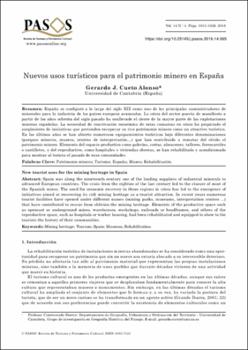Nuevos usos turísticos para el patrimonio minero en España
Autor
Cueto Alonso, Gerardo J.Fecha
2016Resumen
España se configuró a lo largo del siglo XIX como uno de los principales suministradores de minerales para la industria de los países europeos avanzados. La crisis del sector puesta de manifiesto a partir de los años ochenta del siglo pasado ha conllevado el cierre de la mayor parte de las explotaciones
mineras españolas. La necesidad de reactivación económica de estas comarcas en crisis ha propiciado el surgimiento de iniciativas que pretenden recuperar su rico patrimonio minero como un atractivo turístico. En los últimos años se han abierto numerosos equipamientos turísticos bajo diferentes denominaciones
(parques mineros, museos, centros de interpretación…) que han contribuido a rescatar del olvido el patrimonio minero. Elemento del espacio productivo como galerías, cortas, almacenes, talleres, ferrocarriles o castilletes, y del reproductivo, como hospitales o viviendas obreras, se han rehabilitado y acondicionado
para mostrar al turista el pasado de esas comunidades Spain was along the nineteenth century one of the leading suppliers of industrial minerals to
advanced European countries. The crisis from the eighties of the last century led to the closure of most of
the Spanish mines. The need for economic recovery in these regions in crisis has led to the emergence of
initiatives aimed at recovering its rich mining heritage as a tourist attraction. In recent years numerous
tourist facilities have opened under different names (mining parks, museums, interpretation centers ...)
that have contributed to rescue from oblivion the mining heritage. Elements of the productive space such
as opencast or underground mines, warehouses, workshops, railroads or headframes, and others of the
reproductive space, such as hospitals or worker housing, had been rehabilitated and equipped to show to the
tourists the history of their communities.





